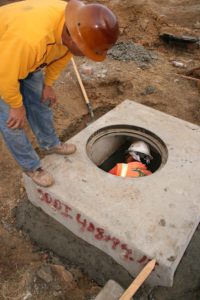Hydrogen sulphide (H2S) is known for being extremely toxic, as well as highly corrosive. In an inerted tank environment, it poses an additional and serious hazard combustion which, it is suspected, has been the cause of serious explosions in the past.
Hydrogen sulphide can be present in %vol levels in “sour” oil or gas. Fuel can also be turned ‘sour’ by the action of sulphate-reducing bacteria found in sea water, often present in cargo holds of tankers. It is therefore important to continue to monitor the level of H2S, as it can change, particularly at sea. This H2S can increase the likelihood of a fire if the situation is not properly managed.
Tanks are generally lined with iron (sometimes zinc-coated). Iron rusts, creating iron oxide (FeO). In an inerted headspace of a tank, iron oxide can react with H2S to form iron sulphide (FeS). Iron sulphide is a pyrophore; which means that it can spontaneously ignite in the presence of oxygen
Excluding the elements of fire
 A tank full of oil or gas is an obvious fire hazard under the right circumstances. The three elements of fire are fuel, oxygen and an ignition source. Without these three things, a fire can’t start. Air is around 21% oxygen. Therefore, a common means to control the risk of a fire in a tank is to remove as much air as possible by flushing the air out of the tank with an inert gas, such as nitrogen or carbon dioxide. During tank unloading, care is taken that fuel is replaced with inert gas rather than air. This removes the oxygen and prevents fire starting.
A tank full of oil or gas is an obvious fire hazard under the right circumstances. The three elements of fire are fuel, oxygen and an ignition source. Without these three things, a fire can’t start. Air is around 21% oxygen. Therefore, a common means to control the risk of a fire in a tank is to remove as much air as possible by flushing the air out of the tank with an inert gas, such as nitrogen or carbon dioxide. During tank unloading, care is taken that fuel is replaced with inert gas rather than air. This removes the oxygen and prevents fire starting.
By definition, there is not enough oxygen in an inerted environment for a fire to start. But at some point, air will have to be let into the tank – for maintenance staff to safety enter, for example. There is now the chance for the three elements of fire coming together. How is it to be controlled?
- Oxygen has to be allowed in
- There may be present FeS, which the oxygen will cause to spark
- The element that can be controlled is fuel.
If all the fuel has been removed and the combination of air and FeS causes a spark, it can’t do any harm.
Monitoring the elements
From the above, it is obvious how important it is to keep track of all the elements that could cause a fire in these fuel tanks. Oxygen and fuel can be directly monitored using an appropriate gas detector, like Gas-Pro TK. Designed for these specialist environments, Gas-Pro TK automatically copes with measuring a tank full of gas (measured in %vol) and a tank nearly empty of gas (measured in %LEL). Gas-Pro TK can tell you when oxygen levels are low enough to be safe to load fuel or high enough for staff to safely enter the tank. Another important use for Gas-Pro TK is to monitor for H2S, to allow you judge the likely presence of the pryophore, iron sulphide.


 Working in the office makes it easy to focus on the individual tasks and get detached from how our products are making a difference to people’s lives. One of our customers was kind enough to facilitate an onsite visit so that Andrea (our Halma Future Leader on a marketing placement) could see first-hand how our products are used and who the end users are. This meant a visit to an oil refinery to see where our Crowcon portable gas detectors are used.
Working in the office makes it easy to focus on the individual tasks and get detached from how our products are making a difference to people’s lives. One of our customers was kind enough to facilitate an onsite visit so that Andrea (our Halma Future Leader on a marketing placement) could see first-hand how our products are used and who the end users are. This meant a visit to an oil refinery to see where our Crowcon portable gas detectors are used.
